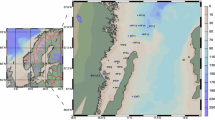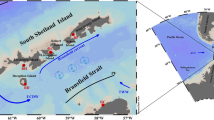Abstract
A method based on time-series of conductivity, temperature and depth (CTD) profiles which successfully determines favourable phytoplankton growth conditions for the spring bloom in nearshore temperate coastal waters was developed. The potential for shallow embayments to influence phytoplankton species composition in larger adjacent waters was also investigated. At temperate latitudes, such embayments should have favourable phytoplankton growth conditions earlier in the spring than open waters as bathymetry limits vertical mixing and thus increases light availability. The study area was Nanoose Bay, which is connected to the Strait of Georgia, British Columbia. Data were collected 2–3 times per week during the winter-spring of 1992 and 1993. A mooring with 5 current meters was placed at the mouth of the bay in 1992. The conservation equation for a scalar was used to estimate the balance between advective transport and biological source and sink terms. Variability in physical conditions and biological response between years was tremendous. Results indicate that seeding from the bay was not possible in 1992 but could have been in 1993. However, to conclusively determine the importance of Nanoose Bay on the spring bloom species composition in the Strait of Georgia, more extensive work is required.
Similar content being viewed by others
References
Baker, P. and S. Pond (1995): The low frequency residual circulation in knight inlet, British Columbia. J. Phys. Oceanogr., 25, 747-763.
Bell, G. R., W. Griffioen and O. Kennedy (1974): Mortalities of pen-reared salmon associated with blooms of marine algae. p. 58-60. In Northwest Fish Culture Conference, 25th Anniversary, December 4–6, 1974, Seattle, Washington.
Campbell, J. and T. Aarup (1989): Photosynthetically available radiation at high latitudes. Limnol. Oceanogr., 34, 1490-1499.
Conover, R. J. (1978): Transformation of organic matter. p. 277-288. In Marine Ecology: A Comprehensive, Integrated Treatise on Life in Oceans and Coastal Waters, Vol. 4, ed. by O. Kine, John Wiley & Sons, New York.
Davis, C. O., J. T. Hollibaugh, D. L. R. Seibert, W. H. Thomas and P. J. Harrison (1980): Formation of resting spores by leptocylindricus danicus (bacillariophycae) in a controlled experimental ecosystem. J. Phyc., 16, 296-302.
Durbin, E. (1978): Aspects of the biology of resting spores of thalassiosira nordenskioldii and detonula confervacea. Mar. Biol., 45, 31-37.
Falkowski, P. G. and T. Owens (1978): Effects of light intensity on photosynthesis and dark respiration in 6 species of marine phytoplankton. Mar. Biol., 45, 289-295.
Freeland, H. J. and D. M. Farmer (1980): Circulation and energetics of a deep, strongly stratified inlet. Can. J. Fish. Aquat. Sci., 37, 1398-1410.
Garrison, D. L. (1984): Planktonic diatoms. p. 1-17. In Marine Plankton Life Cycle Strategies, ed. by K. A. Steidinger and L. M. Walker, CRC Press Inc., Boca Raton, U.S.A.
Gran, H. H. (1912): Pelagic plant life. p. 000-000. In The Depths of the Ocean, Chap. 6, ed. by J. Murray and J. Hjort, Macmillan, London, U.K.
Haigh, R. and F. J. R. Taylor (1990a): Distibution of potentially harmful phytoplankton species in the northern strait of Georgia, British Columbia. Can. J. Fish. Aquat. Sci., 47, 2339-2350.
Haigh, R. and F. J. R. Taylor (1990b): Mosaicism of microplankton communities in the northern Strait of Georgia, British Columbia. Can. J. Fish. Aquat. Sci., 47, 2339-2350.
Hansen, D. V. and M. J. Rattray (1966): New dimensions in estuary classification. Limnol. Oceanogr., 11, 319-326.
Hargraves, P. E. and F. W. French (1983): Diatom resting spores: significance and strategies. p. 49-68. In Survival Strategies of the Algae, ed. by G. A. Fryxell, Cambridge University Press, Cambridge, U.K.
Harrison, P.J., J.D. Fulton, F.J.R. Taylor and T. Parsons (1983): Review of the biological oceanography of the strait of georgia: pelagic environment. Can. J. Fish. Aquat. Sci., 40, 1064-1094.
Harrison, W. G. and T. Platt (1986): Photosynthesis-irradiance relationships in polar and temperate phytoplankton populations. Polar Biol., 5, 153-164.
Hollibaugh, J., D. L. R. Siebert and W. H. Thomas (1981): Observations on the survival and germination of resting spores of three chaetoceros (bacillariophyceae) species. J. Phycol., 17, 1-9.
Holloway, P. E. (1996): A field investigation of water exchange between a small coastal embayment and an adjacent shelf. p. 145-158. In Mixing in Estuaries and Coastal Seas, ed. by C. Pattiaratchi, American Geophysical Union, Washington, D.C., U.S.A.
Ianson, D. (1994): An investigation of possible phytoplankton seeding in the strait of georgia from nanoose bay. Master's Thesis, University of British Columbia, Vancouver, B.C.
Parsons, T. R. and R. J. LeBrasseur (1970): The availability of food to different trophic levels in the marine food chain. p. 325-343. In Marine Food Chains, ed. by J. H. Steele, Oliver and Boyd, Edinburgh, U.K.
Parsons, T. R., K. Stephens and R. J. LeBrasseur (1969): Production studies in the strait of georgia. part 1. Primary production under the fraser river plume, february to may, 1967. J. exp. mar. Biol. Ecol., 3, 51-61.
Parsons, T. R., M. Takahashi and B. Hargrave (1973): Biological Oceanographic Processes. Pergamon Press, Oxford, U.K.
Parsons, T. R., Y. Maita and C. M. Lalli (1984): A Manual of Chemical and Biological Methods for Seawater Analysis. Pergamon Press, Oxford, U.K.
Pond, S. and G. L. Pickard (1983): Introductory Dynamical Oceanography. 2nd ed., Pergamon Press, Oxford, U.K.
St. John, M. A., J. Stonach, P. J. Harrison and R. J. Beamish (1993): A horizontally resolving physical-biological model of nitrate concentration and primary productivity in the strait of georgia. Can. J. Fish. Aquat. Sci., 50, 1456-1466.
Sutherland, T. F., C. Leonard and F. J. R. Taylor (1992): A segmented pipe sampler for integrated profiling of the upper water column. J. Plankton Res., 14, 915-923.
Sverdrup, H. U. (1953): On conditions for the vernal blooming of phytoplankton. J. Cons. Explor. Mer, 18, 287-295.
Taylor, F. J. R. (1993): Current problems with harmful phytoplankton blooms in British Columbia waters. p. 699-703. In Toxic Phytoplankton Blooms in the Sea, ed. by T. J. Smayda and Y. Shimizu, Elsevier, Amsterdam.
Taylor, F. J. R. and R. Haigh (1993): The ecology of fish-killing blooms of the chloromonad flagellate heterosigma in the strait of georgia and adjacent waters. p. 705-710. In Toxic Phytoplankton Blooms in the Sea, ed. by T. J. Smayda and Y. Shimizu, Elsevier, Amsterdam.
Yang, C. and L. Albright (1994): Oxygen-radical-mediated toxic effects of H. carterae on juvenile salmonoids. In Abstracts of Oral Presentations, Fourh Canadian Workshop on Harmful Marine Algae.
Yin, K., P. J. Harrison, R. H. Goldblatt, M. A. St. John and R. J. Beamish (1997): Factors controlling the timing of the spring bloom in the strait of georgia estuary, British Columbia, Canada. Can. J. Fish. Aquat. Sci., 54, 1985-1995.
Author information
Authors and Affiliations
Rights and permissions
About this article
Cite this article
Ianson, D., Pond, S. & Parsons, T. The Spring Phytoplankton Bloom in the Coastal Temperate Ocean: Growth Criteria and Seeding from Shallow Embayments. Journal of Oceanography 57, 723–734 (2001). https://doi.org/10.1023/A:1021288510407
Issue Date:
DOI: https://doi.org/10.1023/A:1021288510407




